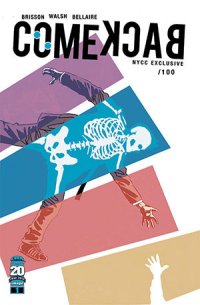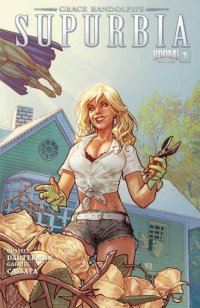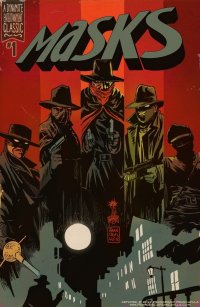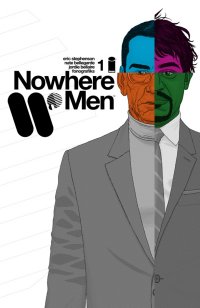Comeback #1 (of 5)(Image, $3.50)
by Graig Kent
Comeback starts with two suspicious gentlemen posing as representatives from an energy company kidnapping a homeowner at his front door and ends with a long drive to a deserted location. In between those two points — points which would lead you to think this was a fairly conventional crime story — there’s clandestine meetings in seedy bars, assignments and dossiers being doled out, and tension between partners as one of them wants out of the business.
Actually, that still sounds fairly conventional, doesn’t it?
Oh, right. I forgot the part about time travel.
This is indeed a crime story, but a different type of crime story. Without spoiling too much, there’s an organization, Re-connect that has (in a yet-to-be-detailed manner) obtained a machine that allows people to travel in time. This organization offers a service, on the down-low, which allows those who can afford it to cheat death, somewhat retroactively. Well, potentially at least, as it would seem the time travel process isn’t foolproof.
Little is as it seems at first in Comeback, and creator/writer Ed Brisson does a impressive job with unfolding his story and characters here. He uses all those conventions and tropes of crime stories mentioned above to maximum effect, delivering to the reader a familiar scenario, then continually twisting in it, but gently so it’s not in your face with cleverness. The scenarios all layer upon one another, forming a fairly stable whole, though certainly not yet complete.
Re-connect’s general operational model, by the end of this first issue, seems fully apparent. But with a second reading, I’m second-guessing what I’ve read. There could be more twisting in store: is Re-connect actually providing a genuine service, and are they being undercut by more nefarious criminal enterprises? What does it all means for the people involved and how have the science fictions concepts introduced affected the world at large?
Illustrator Michael Walsh works in a style not too dissimilar to Sean Philips, Michael Lark or Charlie Adlard, with heavy inks and solid lines, and no subtle shading. It’s certainly an effective style for the type of story being told and he has a strong ability to deliver talking heads. Altogether Comeback is unassuming but engaging, drawing the reader in with sharp genre play and stimulating concepts.
Rating: 




Out of a Possible 5 Stars
 Supurbia #1 (Boom!, $3.99)
Supurbia #1 (Boom!, $3.99)
By Jeb D.
Grant Morrison wasn’t the first person to note that soap opera is at the core of the success of ongoing superhero properties like the X-Men, and Grace Randolph brings the concept into the 21st century, with her Desperate Housewives-meets-Astro-City series, Supurbia. The superheroes of this series aren’t the hormonal kids of the Xavier school, but adults, burdened with family, relationships, and obligations that are more mundane, but no less challenging, than saving the universe now and then.
The story is set in a suburban housing development where the members of the JLA-like Meta Legion live in secret with their families: there are lawns to be mowed, cookouts to plan, kids’ activities to participate in… and all the jealousy, back-biting, intrigue, and infidelity that we all know lurks just beneath the placid surface of all suburban neighborhoods.
In the four-issue miniseries that introduced the concept, Randolph did a deft job of introducing her large cast of supers, along with their assorted spouses, kids, friends and hangers-on; the plotting avoided the typical superhero apocalypse and instead focused on the jealousies, secrets, and petty hurts that threatened to destroy the Legion more effectively than any super-foe (though she did provide them with a formidable one). Her writing was effective at both delineating character in quickly sketched relationships, and providing just enough amusing snark and a modicum of action to keep the story from getting too bogged down-no easy task given the size of the ensemble. And like Busiek, she has a great feel for the specific ways that her characters’ “powers and abilities” can shape their strengths and weaknesses: Sovereign has the calm arrogance of a Superman-like being with virtually no limits, while the Wonder Woman analog, Batu, is as disturbingly alien in her personality as in her abilities (Randolph is also one of the few writers to effectively explore the implications of a gay relationship between a billionaire vigilante and his no-longer-a-kid sidekick). Though there was, in fact, some villainous scheming aimed at the Legion members, it served more as punctuation than anything else: Supurbia is at its best when weaving in and out of its dense assortment of individual characters’ weaknesses and betrayals.
In restarting the series as an ongoing, Randolph makes the prudent assumption that she has to introduce the cast for newbies, while providing enough new story meat for those who’ve read the original mini; she does her best, but there’s no question that this first issue groans here and there under the weight of necessary exposition, mountains of word balloons, and quick-cutting: in other words, if you read the Supurbia mini, you’re only getting a few crumbs of new storyline here and there, while the last-panel splash page seems a bit underwhelming, given that it introduces a development whose threat level seems a bit on the mild side, relative to what’s come before. Still, given how packed the original miniseries was with memorable character interaction, I’m willing to stick around for a few issues, confident that Randolph will crank the heat from simmer to boil in short order.
The art team of Russell Dauterman and Gabriel Cassata rises to the challenge of making the super-analogs feel convincingly familiar, while sharply delineating the other characters: it’s never hard to distinguish who we’ve met before and who we haven’t, even when a character is glimpsed only briefly. They’re also adept at the soap opera staple of showing us characters hiding their thoughts and emotions from the rest of the world, while using facial expression and body language to communicate them clearly to the reader. The style is more cartoony than something like Astro City, but its angularity is a propos: a visual metaphor for the sharp edges all the characters are maneuvering. Randolph doesn’t hand her artists a lot of action to illustrate, but they compensate with inventive visual angles, and fluid layout.
I’ll admit that I’m scoring this issue a bit higher than it might warrant as a standalone, but knowing just how well Randolph pulled off the first Supurbia miniseries, I’m willing to grade heavily on future potential.
Rating: 




Out of a Possible 5 Stars
Masks #1 (Dynamite, $3.99)

by Graig Kent
In superhero comics, the cross-over is expected, a constant, and at this stage the “event” of heroes gathering is achingly routine. Comparatively, the pulp heroes, with their disparate copyright holders and rotating licensees, don’t blend all that often (I guess the DC “First Wave” a few years back was the last time this happened) and so it’s an interesting — for some exciting — prospect to put them together and see what happens.
My familiarity with the pulp heroes in Masks is very, very limited. With most of them I’ve had some exposure to their other media appearances, like the Green Hornet TV show, or a few Zorro films, or the radio plays of the Shadow (as well as the Alec Baldwin feature from the mid-90’s and a few of the comics from the ’80’s), but I am by no means a fan these characters. I honestly can’t recall ever reading an authentic pulp story featuring any of them, either.
So with Masks I come in relatively fresh, with few preconceptions. I understand the assembly of these characters is an “event” of sorts, and having Alex Ross handling art certainly escalates its status, but I have no idea what this pulp-vigilante team-up should be, nor how these characters should act normally, or in relation to one another. By the end of the first issue, I still don’t.
There’s honestly no characterization going on within the pages of the first issue. Like any team-up from the big two, there’s the assumption that you know who these characters are and what they’re about. It’s a pretty major fault, as I’m certain this will be more than a few readers’ first exposure to these characters.
Chris Roberson was charged with scripting the assembly and in every way it feels like a forced effort, that these characters do not belong on the same page or in the same story as one another. The book kicks off in a back alley with the classic “hero misunderstanding” in which Kato and the Green Hornet square off, ever so briefly, with the Shadow, who proves himself their superior, at least physically, though perhaps not morally. In short order they meet in their civilian guises to discuss the unsettling rise of the fascist (and criminally-backed) Justice Party who seem to not only assemble but take control of the state of New York in the time it takes Britt Reid and Lamont Cranston to finish their coctkails and conversation.
Soon a Schutzstaffel-like force has overrun New York, arresting people for absurd reasons, implementing impromptu and irrational taxes, and generally being Nazi-like bad guys on 1930s-esque American soil. Ironically, for all the realism in Ross’ painted illustration, the scenario and the situations that spill out of them are decidedly cartoony. The heroes present no plan of action to bring down “the law” (and there’s at least three different discussions on “justice”, and how it differs from “the law”, just to be sure that point is driven home) beyond the issue-ending rally of vigilantes who decide that bashing and shooting everyone in sight is the answer. Unfortunately for them, the well armored Justice Party police are well protected form bullets and stun guns, so I guess they’re kind of screwed.
I think at the foundation of this story and set-up there’s a valiant, but failed, attempt to connect with these characters pulp roots. Roberson and Ross strive for that sensationalistic feel, the stark contrast between good and bad, but it all comes off as hokey. Not old fashioned, just not good. If this is how indelicately these heroes are thrust together, and how obvious it is they don’t belong together, I can only imagine how ungainly the inclusion of Zorro will be.
Ross’s art is as reality-based as it ever was. If you liked his art before, you’re going to key into it here (it’s really the only one of the book’s draws that delivers), but if you’re not a fan of what Ross does, nothing here will change your mind. I like his panel layouts, particularly the first page which toys with angles and orientation, and he knows how to paint a scene, with the meeting in the Cobalt Club defining the word “swank”.
However being a showcase for Ross’ art means pages tend to max out at four panels and splash pages are frequent, so for a 22-page book it feels light and short. Having little connection to the characters I have no excitement for their meeting, and the book provides no anticipation so it’s all rather plain and unfortunate spectacle.
Rating: 




Out of a Possible 5 Stars
 New Avengers #34 (Marvel, $3.99)
New Avengers #34 (Marvel, $3.99)By Jeb D.
OK, you can come out now… he’s gone.
I think it’s safe to say that nothing Brian Bendis has done in his years at Marvel has enraged more fans than his shepherding of the Avengers from its familiar concept of Captain America and a loose collection of B-listers (Hawkeye, Scarlet Witch, Black Widow, etc.) to Marvel’s big-guns version of the Justice League. Given the recent success (to put it mildly) of the Marvel movie-verse, it would be fair to say that some of what he did laid the groundwork for that epic achievement… but that wouldn’t excuse his constant cramming of characters like Spider-Man, Wolverine and Ben Grimm into a team that contractual restrictions would keep them from joining in the films, anyway. And even if the corporate demands of the reinvigorated Marvel dictate such moves, Bendis has never shown much interest in making it a graceful integration: Parker and Logan are just there, and every few issues someone makes a remark on how it’s really not that odd. Which is particularly disappointing, given Bendis’ affinity for characters like Dr. Strange, Spider-Woman, and Luke Cage: the kind of second-bananas who generally can’t carry their own ongoing series, but who can be the focus of interesting stories in a team book; I don’t need their face-time reduced for yet another round of Spidey’s quippiness or Logan’s snarl.
In this final issue of his Avengers run (I’ve lost count of how many different actual series that’s encompassed), Bendis resets the table for upcoming writers like Jonathan Hickman and Kelly Sue DeConnick: following Daniel Drumm’s assault on the team and murder of Veronica Hand, Dr. Strange must stand against the possessed versions of his teammates, and after a bonus-sized issue’s worth of fight scenes, we get back to status quo ante: I suppose I’m sort of spoiling things when I say that the entire purpose of it was to re-establish Strange as the Marvel U’s Sorcerer Supreme, but I’m not sure that distinction has ever been a particularly important one: Strange fights mystical foes with mystical powers, that’s his thing; whether he’s wearing the official cloak matters more to cover artists than anyone else.
Given that the dialogue in most of this issue is (for Bendis) pretty economical and on-point, and that the scene of Luke Cage and Jessica Jones’s farewell to the Avengers is a sweetly funny love letter from the writer to those fans who have stuck with him on the series, it’s also disappointing that what could have been a pretty effective super-throwdown if left in the capable hands of artist Mike Deodato instead is turned into the kind of distracting artist jam that marred Bendis’ 50th issue of Daredevil (forever infamous for its single embarrassing panel by Gene Colan, who had clearly not been told what the hell was going on in the book), with a fistful of artists getting a page apiece of the big fight to whip the reader’s head around like Linda Blair. It’s particularly jarring since the guest artists (including Black Metal‘s Chuck BB, Pop Gun War‘s Farel Dalrymple, and Bendis pal Becky Cloonan) have styles that range from crude to cartoony, but all are pretty much polar opposites to Deodato’s lush blend of the super and the sensual. Some of the interpolations might work on their own (Lucy Kinsley’s Strange-Cap encounter is actually kinda cute, and Ming Doyle’s interpretation of Ben Grimm is intriguingly monstrous), but not only are they distracting, they’re inconclusive: from page to page, it’s actually hard to tell who’s winning which fights till Deodato returns to wrap things up. Given its apocalyptic nature, this brawl should have felt epic; instead, the artist jam makes it come off more goofy than anything else.
I won’t particularly miss Bendis on the Avengers, not because I don’t like his writing (he can be hit or miss for me, but generally enjoyable), but because the “big guns” version of the team was not only less interesting to me, but Bendis himself seemed less invested in it: go back through his nearly 300 Avengers issues, and replace the amount of time spent on overexposed characters like Spider-Man and Wolverine with more focus on Jessica Jones or Danny Rand, and you’d have something closer to a Bendis book achieving its real potential. And with a final issue whose strong script is marred by erratic art, I can’t really muster up much of a recommendation.
Rating: 




Out of a Possible 5 Stars
Nowhere Men #1 (Image, $2.99)
by Graig Kent
I know I’m not alone in my appreciation of Image Comics’ output this year. They continue to deliver fascinating, high-concept, well-executed, original content that has made me more excited for the medium and the format of monthly comics than any Marvel Now or New 52. I’m routinely crossing titles off my monthly pull from the big two to add a new one from Image. Manhattan Projects, Think Tank, Saga, Storm Dogs, Non-Humans, and more that I’m trade waiting on. This month alone delivered Great Pacific, Comeback (reviewed above) and now Nowhere Men.
Part of it is Image is letting creators cut loose with the format. They’re not being constrained to 20 or 22 pages. If they want to run their story through to the inside back cover, they can, or have a four-page letter column, go for it. Nowhere Men is cover-to-cover, starting with a flashback, a two-page “magazine profile” on the main characters, a main story spit in two by an immaculately designed center page advertisement, and closing the book out with a two page interview with one of the main characters.
Created and written by Image’s publisher Eric Stephenson, there’s appreciable effort put into the overall package, from the cover, logo, and ancillary designs to the character and world building within the book’s pages. The core idea revolves around a “supergroup” of super-scientists who form a company, World Corp, in the 1960s that, literally, revolutionizes the world. Cut to present day: World Corp. is the largest, most powerful company on the planet. Its owners, now a trio down from a quartet, are at odds with the direction the company is taking, ethics, ambition and egos all clashing. It’s the foundation of the book, but what this fracturing partnership really means is not yet clear.
In Nowhere Men‘s second half, we catch a another look at what’s happening inside World Corp., deep inside. A team of scientists, all suffering from a malady that manifests differently in each host, learn that not only are they quarantined indefinitely, but that the project they very well may have sacrificed their lives for is being shut down. It’s all intrigue, no action, and it’s rather fantastic.
The level of depth which Stephenson has worked out his concept is apparent, given all the extracurricular material, but he’s showing only slightly past the surface level at this point. This isn’t just a set up, but seeding ideas for future drama and conflict. I’m reminded of Massive Dynamic from the TV series Fringe, somewhat, with the powerful super-science gone awry, only less monster-of-the-week and a more in-depth exploration of the ethics of capitalistic science.
Stephenson is joined by artist Nate Bellegarde, whose ultra clean setting and character designs are reminiscent of Jamie McKelvie with a bit of a Chris Sprouse flair. I’m not very familiar with his previous work, skirting around the fringes of Image comics, but this is truly a showcase for him, a confident display of storytelling and strong sense of physicality.
This type of corporate vanguard story is not unique in comics, but they’re irregular enough that they’ve yet to feel tiresome or derivative, and when they’re well done they add a compelling alternative to the status quo, and with this a fine addition to Image’s exceptional roster of alternatives.
Rating: 




Out of a Possible 5 Stars